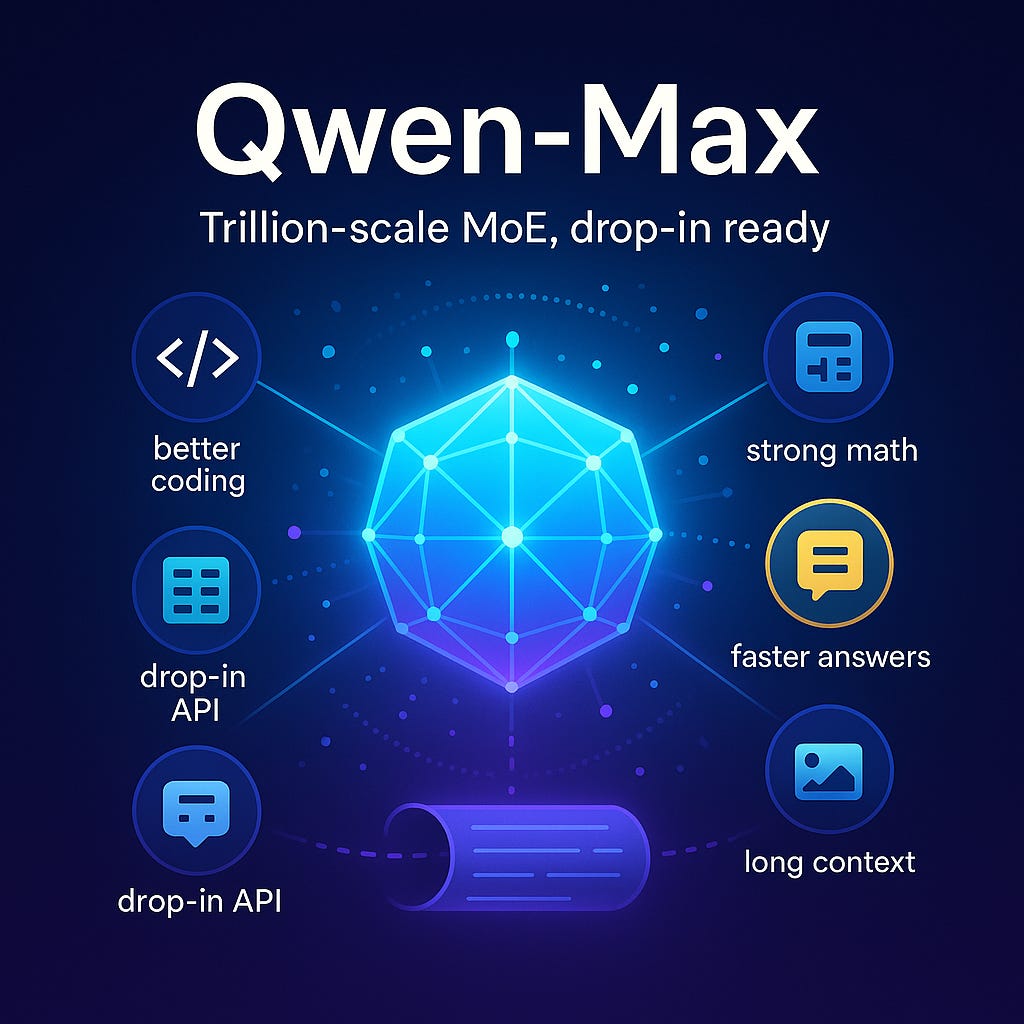The Sequence Radar #715: Qwen-Max: The Trillion-Parameter MoE You Can Actually Ship
Was this email forwarded to you? Sign up here The Sequence Radar #715: Qwen-Max: The Trillion-Parameter MoE You Can Actually ShipOne of the most impressive releases of the generative AI era.Next Week in The Sequence:
Subscribe Now to Not Miss Anything:📝 Editorial: The Trillion-Parameter MoE You Can Actually ShipAlibaba Qwen just released one of the most impressive AI models ever created. Qwen‑Max was introduced as the flagship tier of the Qwen 2.5 lineup from Alibaba Cloud, rolled out through DashScope/Model Studio with an OpenAI‑compatible endpoint. The launch message was straightforward: bring a frontier‑class Mixture‑of‑Experts (MoE) model to production developers with minimal integration friction, highlight strengths in math/coding and long‑form reasoning, and pair the managed “Max” service with open‑weight and multimodal siblings so teams can choose the right deployment style for each workload. While it isn’t the first trillion‑parameter model—research MoEs crossed that line years ago—it’s the first trillion‑scale entry publicly positioned as a flagship among the major production chat stacks. Qwen‑Max is Alibaba Cloud’s flagship MoE language model, delivered through an OpenAI‑compatible API. In practice, that means you can point your existing Chat Completions client at a new base URL and get frontier‑class behavior—no SDK rewrites. The contribution that matters most here is pragmatic accessibility: Qwen‑Max packages extreme‑scale training and modern alignment into an interface developers already know, lowering the friction to evaluate and deploy a top‑tier model. Under the hood, MoE gives Qwen‑Max high capacity without paying the full dense‑model cost for every token. A router activates a small subset of specialized “experts” per token, concentrating compute where it’s useful and skipping the rest. The tricky part with MoE is stability—avoiding collapsed routing, underused experts, or training instabilities. Qwen‑Max’s recipe (large‑scale pretraining followed by staged SFT and RLHF) shows that you can keep experts well‑utilized and instruction following strong, making sparse models dependable enough for production. On capability, Qwen‑Max performs especially well on math, code, and hard multi‑step prompts—the stuff that actually blocks teams in daily workflows. It handles long‑form reasoning, tool use, and structured outputs with fewer derailments, which translates to less prompt‑engineering contortion and fewer fallbacks. For engineering teams, that combination—reasoning quality plus reliability—often matters more than leaderboard bragging rights because it shows up as higher task completion rates and lower human‑in‑the‑loop load. A second, underappreciated contribution is the surrounding ecosystem. The Qwen family spans open‑weight models for on‑prem customization, multimodal variants for vision+language, and long‑context options for document‑heavy retrieval. That spectrum lets you mix and match: keep open models where data governance or latency demands it, and call Qwen‑Max in the cloud when you need peak accuracy on the hardest tasks. It’s a practical template for regulated environments that still want access to frontier‑level capability. Operationally, Qwen‑Max is easy to slot into modern stacks. API compatibility enables quick A/B tests behind a router, so you can pit it against incumbents using your own eval harness and decide on the basis of latency × quality × cost. MoE’s sparsity further improves cost‑per‑useful‑token at a given quality target, which is what matters to finance, analytics, and dev‑assist workloads that are both compute‑intensive and quality‑sensitive. The roadmap also signals continued pressure at the high end (larger MoE, longer context windows) without abandoning ergonomics. That pace of iteration is itself a contribution: it suggests we don’t have to choose between scale, alignment, and developer experience. For teams deciding when to try it: if your bottlenecks are reasoning‑heavy tasks (complex coding, data analysis, policy‑aware generation) and you value drop‑in integration, Qwen‑Max is a compelling candidate to run through your internal evals. 🔎 AI ResearchOpen Data Synthesis for Deep ResearchAI Lab: BAAI Jointly Reinforcing Diversity and Quality in Language Model GenerationsAI Lab: Meta FAIR, Carnegie Mellon University, Johns Hopkins University SimpleTIR: End-to-End Reinforcement Learning for Multi-Turn Tool-Integrated ReasoningAI Lab: Nanyang Technological University, TikTok The Landscape of Agentic Reinforcement Learning for LLMs: A SurveyAI Lab: National University of Singapore, University of Oxford, Shanghai AI Lab, UCL, UIUC, Brown, Imperial College, CAS, CUHK, Fudan, Bristol, Georgia, UCSD, UCSB, Dalian Univ. of Tech Towards a Unified View of Large Language Model Post-TrainingAI Lab: Tsinghua University, Shanghai AI Lab, WeChat AI Loong: Synthesize Long Chain-of-Thoughts at Scale through VerifiersAI Lab: CAMEL-AI.org 🤖 AI Tech ReleasesQwen-Max-PreviewAlibaba just released Qwen-Max-Preview, a massive 1 trillion parameters model. EmbeddingGemmaGoogle released EmbeddingGemma, a new open sourced embedding model with state of the art performance. Le Chat MCP ConnectorsMistral released a new set of MCP connectors in its Le Chat platform. 📡AI Radar
You’re on the free list for TheSequence Scope and TheSequence Chat. For the full experience, become a paying subscriber to TheSequence Edge. Trusted by thousands of subscribers from the leading AI labs and universities. |
Similar newsletters
There are other similar shared emails that you might be interested in:


